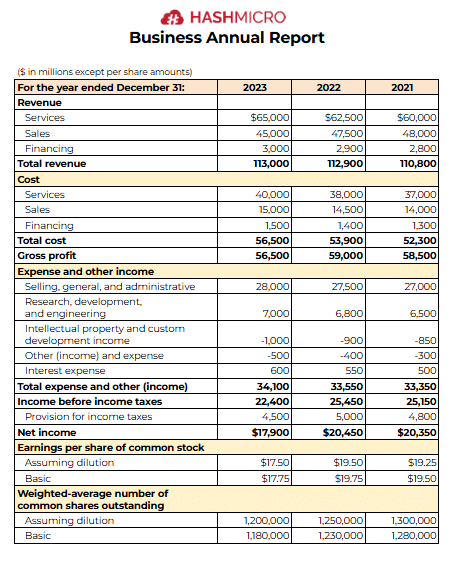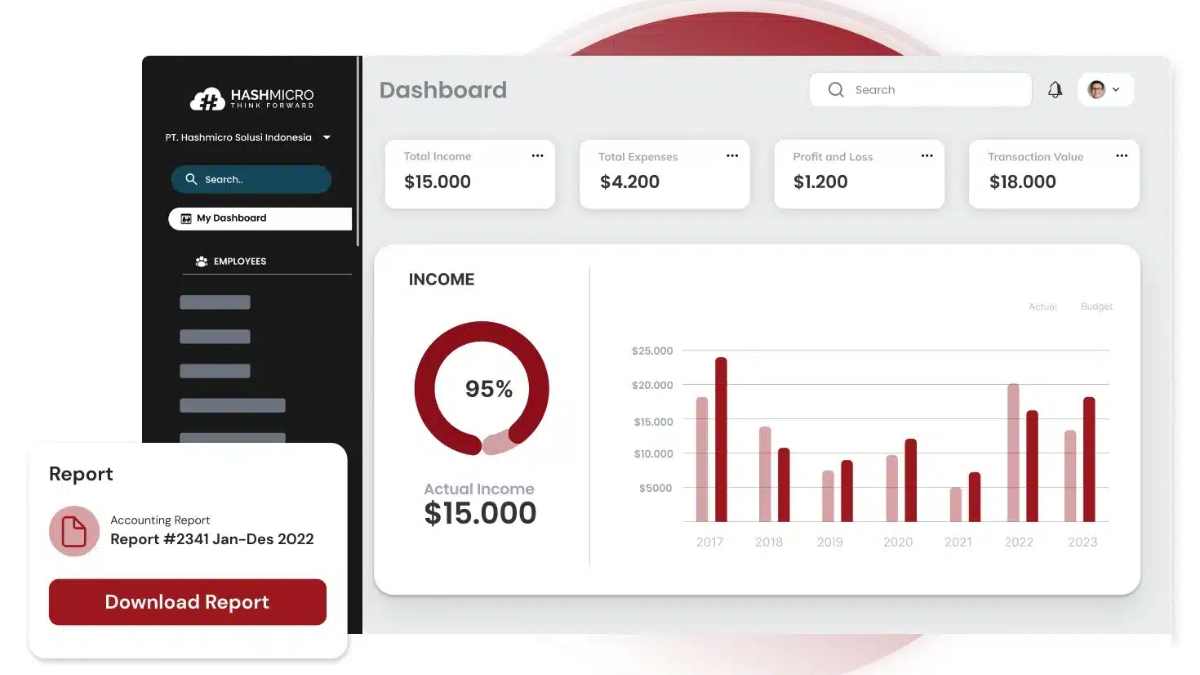An Annual Business Report is a comprehensive document summarizing a company’s financial performance, achievements, and key activities over the past year. This report is crucial for stakeholders, providing insights into the organization’s financial health.
The accounting software market is set to grow 6% annually from 2020 to 2025, driven by the need for advanced tools. These solutions are crucial for accurate and efficient annual business reports.
To address these challenges, HashMicro Accounting Software offers an integrated solution to streamline financial reporting, automate calculations, and enhance data accuracy. Its comprehensive features make preparing annual business reports more efficient and reliable.
In this article, we’ll explore the importance of annual business reports, the challenges of traditional reporting methods, and how HashMicro can simplify the process.
Table of Content:
Table of Content

Key Takeaways
|
What is an Annual Report of a Company?
A business annual report is a formal document summarizing a company’s financial performance, key achievements, and strategic goals over the past year. It is prepared to provide stakeholders with transparent insights through detailed financial statements and management discussions.
This report typically includes key components such as the financial statements, management discussions, analysis, and a review of significant milestones and challenges.
It may also highlight the company’s contributions to corporate social responsibility and sustainability efforts. By presenting this information, an annual report fosters transparency and builds stakeholder trust.
Typically, an annual report contains key sections such as financial statements, management discussions, and a review of significant milestones. It may also highlight sustainability initiatives, market performance, and plans.
By examining the annual report, stakeholders can gain valuable insights into a company’s financial performance, operational efficiency, and strategic direction.
Essential Aspects While Preparing Your Business Annual Report
Preparing a comprehensive business annual report requires careful attention to several critical aspects to ensure accuracy, compliance, and effective communication with stakeholders. Here are the most essential elements to consider:
1. Accurate financial data
Ensure that all financial statements, including balance sheets, income statements, and cash flow reports, are accurate and up-to-date. Cross-check data for errors to maintain credibility and meet regulatory standards.
2. Clear executive summary
Start with a concise executive summary highlighting key achievements, challenges, and financial performance. This section provides a quick overview for readers who may not read the entire report.
3. Compliance with regulations
Adhere to industry-specific reporting standards and legal requirements. This includes following guidelines from regulatory bodies to avoid penalties or reputational risks.
4. Visual representation
Present financial data and performance metrics visually using charts, graphs, and tables. This enhances readability and helps stakeholders understand complex information easily.
5. Transparent management discussion
Include a detailed analysis of operational successes, challenges, and future goals. Transparency in this section builds trust with stakeholders and demonstrates accountability.
6. Focus on sustainability and CSR
Highlight sustainability initiatives and corporate social responsibility (CSR) activities. These aspects showcase the company’s commitment to ethical and sustainable business practices.
By focusing on these aspects, businesses can create an annual report that is both informative and impactful, effectively communicating their performance and vision to stakeholders.
Challenges in Making Business Annual Report
Creating a business annual report involves various challenges. Overcoming these challenges is crucial for producing accurate and reliable reports that reflect a company’s financial health and performance.
1. Manual data entry
One of the significant challenges in preparing a business annual report is the manual data entry involved. This process requires manually inputting a large amount of financial data, which is time-consuming and increases the risk of human error.
Manual data entry also risks inaccuracies in the final report, potentially leading to misleading information and misinterpretations.
2. Inaccurate report
Another challenge that organizations face is the risk of an inaccurate report. Due to the complexity of financial data and the possibility of human error during data entry or calculation, the accuracy of the final report can be compromised.
An inaccurate report may misrepresent the company’s financial performance and impact the decision-making process for stakeholders.
3. Financial data complexity
The complexity of financial data is an inherent challenge in creating business annual reports. Financial data often includes intricate calculations, interrelated metrics, and accounting standards that need to be followed.
This complexity can make it difficult to compile, analyze, and present the information meaningfully and clearly.
4. Limited human resources
Many organizations struggle with limited human resources when preparing the business annual report. The report requires skilled professionals with expertise in accounting, finance, and report writing.
The lack of sufficient resources can add pressure and strain on the existing team, increasing the risk of errors and delays in producing the report.
5. Tight deadline
Another challenge organizations face when preparing the annual report is the time constraint. Businesses must adhere to strict deadlines for submitting financial reports to regulatory bodies or shareholders.
The tight deadline pressures the reporting team to complete the report within a specified timeframe, potentially compromising the quality and accuracy of the final output if not managed effectively.
Overcoming the challenges of creating a business annual report requires careful planning, efficient processes, and leveraging technology to streamline data entry and analysis. Adopting an automation tool like accounting software may help your business to create an accurate and comprehensive business annual report.
Key Components of a Business Annual Report
A well-structured business annual report includes several key components that comprehensively view the company’s performance, achievements, and goals. Here are the essential elements typically found in an annual report:
1. Executive summary
This section concisely overviews the company’s performance, highlighting key achievements, challenges, and financial results. It is a snapshot for stakeholders who prefer a quick understanding of the year’s progress.
2. Financial statements
The financial statements include the balance sheet, income, and cash flow statement. These provide a detailed breakdown of the company’s financial health, profitability, and cash management over the reporting period.
3. Management discussion and analysis (MD&A)
The management team analyzes the company’s operational and financial performance in this section. It includes insights into business strategies, market trends, risks, and future growth plans.
4. Corporate governance report
This part outlines the structure, practices, and responsibilities of the company’s leadership and governance framework. It ensures transparency and accountability in business operations.
5. Sustainability and CSR initiatives
Highlighting sustainability practices and corporate social responsibility (CSR) efforts demonstrates the company’s commitment to ethical and sustainable business operations.
6. Operational highlights
This section details key projects, product launches, market expansions, or milestones achieved during the year. It provides a deeper look into the company’s activities and progress.
7. Auditor’s report
An auditor’s report validates the accuracy of the financial data presented, ensuring compliance with relevant accounting standards and building trust with stakeholders.
By including these key components, a business annual report becomes a powerful tool for showcasing the company’s achievements, maintaining transparency, and strengthening stakeholder relationships.
Steps to Prepare an Annual Report for Your Business
Preparing an annual report requires a systematic approach to ensure it is clear, accurate, and comprehensive. Here are six essential steps:
1. Collect financial data
Gather accurate and complete financial records, including balance sheets, income statements, and cash flow reports. Ensure all data is up-to-date and reconciled to reflect the company’s financial health. This forms the foundation of a reliable and transparent report.
2. Define key sections
Plan the report’s structure into essential sections such as the executive summary, financial data, management analysis, and CSR initiatives. An explicit format ensures readers can navigate the report quickly. Prioritize sections based on stakeholder relevance and compliance needs.
3. Draft the executive summary
Write a concise executive summary highlighting significant achievements, financial outcomes, and future goals. This section serves as a quick reference for stakeholders who may not read the entire document. Focus on impactful details that capture the company’s performance.
4. Incorporate visuals
Use graphs, charts, and tables to present complex financial data and key performance indicators visually. Visual elements make the report more engaging and easier to understand. Ensure that visuals are accurate and align with the accompanying text.
5. Ensure accuracy and compliance
Review the report meticulously to eliminate errors and ensure compliance with legal and industry standards. Double-check financial figures and regulatory requirements to maintain credibility. Accurate reporting builds trust with stakeholders and regulators alike.
6. Seek approvals and distribute
Have management and auditors review and approve the report to validate its content and accuracy. Once finalized, distribute the report in digital and printed formats. Accessibility ensures stakeholders can quickly review and assess the company’s performance.
These steps help create a polished and impactful annual report that meets stakeholder expectations and reinforces trust.
Business Annual Report Example
Understanding financial statements is crucial for evaluating a business’s health. One of the key components often analyzed is the income statement or statement of earnings. Below is an example of an income statement format that can be used as a reference.
business annual report


The table above clearly presents how revenue, costs, and net income are structured. This format helps companies analyze their financial performance and make strategic decisions based on accurate data.
How to Simplify Business Annual Report with HashMicro Accounting System
Creating a business annual report can be time-consuming and complex, especially when dealing with large volumes of financial data. HashMicro Accounting System streamlines this task by automating data collection and report generation.
The system consolidates financial records in real time, eliminating the need for manual data entry and reducing the risk of errors. Here are some of the key features offered:
- Budget Management & S-curve: This feature helps businesses plan, track, and manage budgets efficiently. The integration of S-curve visualization enables monitoring project progress and spending trends over time.
- Revenue, Accounts Receivable, & Receipts Management: Simplify tracking of revenue streams and outstanding payments. The system also automates receipt management to ensure accurate recording and timely collection.
- Cash Flow & Budget Forecasting: This feature lets you gain real-time insights into your cash flow and predict future financial trends. It aids in maintaining liquidity and aligning spending with strategic goals.
- Asset Depreciation Management: Automatically calculate and track the depreciation of fixed assets. This ensures compliance with accounting standards and accurate asset valuation.
- Financial Ratio Analysis: Analyze critical financial ratios, such as profitability, liquidity, and efficiency. This helps evaluate business performance and make informed decisions.
- Automated Currency Update: Stay updated with real-time exchange rates. The system automates currency conversions for businesses dealing with multi-currency transactions.
- Financial Report with Multi-level Analytical: Generate detailed financial reports with multi-layered analysis. This provides an in-depth understanding of business performance across various dimensions.
Conclusion
A business annual report is a comprehensive document that showcases a company’s performance, financial health, and key milestones over the past year. It is a vital stakeholder communication tool, offering transparency and insights into the business’s operations and strategies.
Preparing an accurate and professional annual report provides numerous benefits, including building stakeholder trust, demonstrating accountability, and facilitating informed decision-making. However, the process can be challenging without the right tools.
HashMicro Accounting System simplifies the preparation of business annual reports with its advanced automation, real-time data integration, and user-friendly features. By leveraging this system, businesses can save time, reduce errors, and effortlessly create impactful reports.
Ready to transform the way you prepare annual reports? Try a free demo of HashMicro Accounting System today and experience its efficiency firsthand!
FAQ Business Annual Report
-
What are the 4 reports in a company’s annual report?
They typically gather essential insights about a company by analyzing four types of financial statements included in its Annual Report: the Balance Sheet, the Income Statement, the Cash Flow Statement, and the Statement of Changes in Equity.
-
What is the difference between financial statements and annual report?
Annual reports present a detailed narrative of a company’s progress, while financial statements deliver precise and timely financial data to support thorough analysis and informed decision-making.
-
Is annual report same as audit report?
An annual report usually consists of audited financial statements and a narrative section where management provides an overview of the company’s performance and activities. The narrative portion is generally not subject to auditing.


































